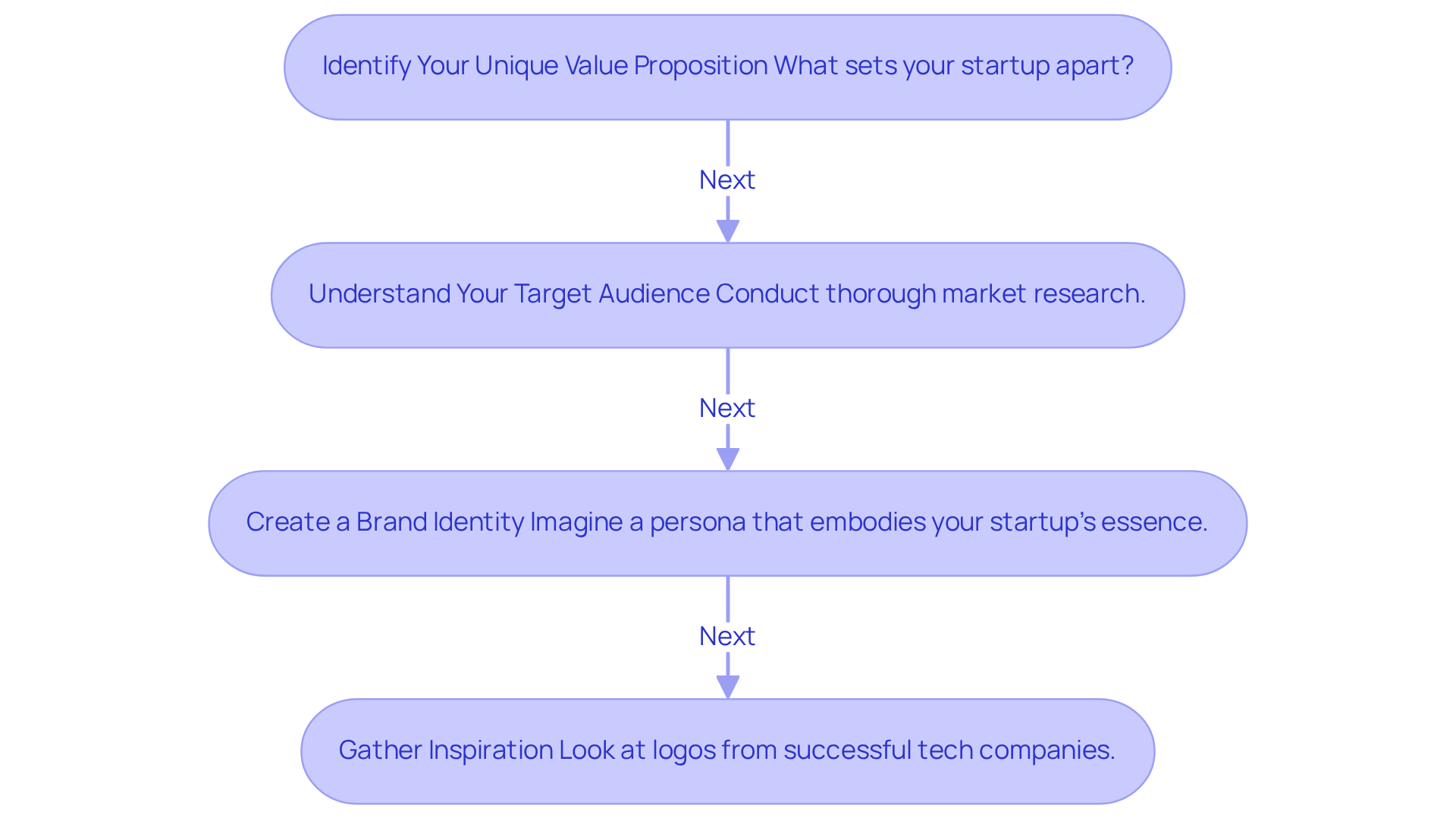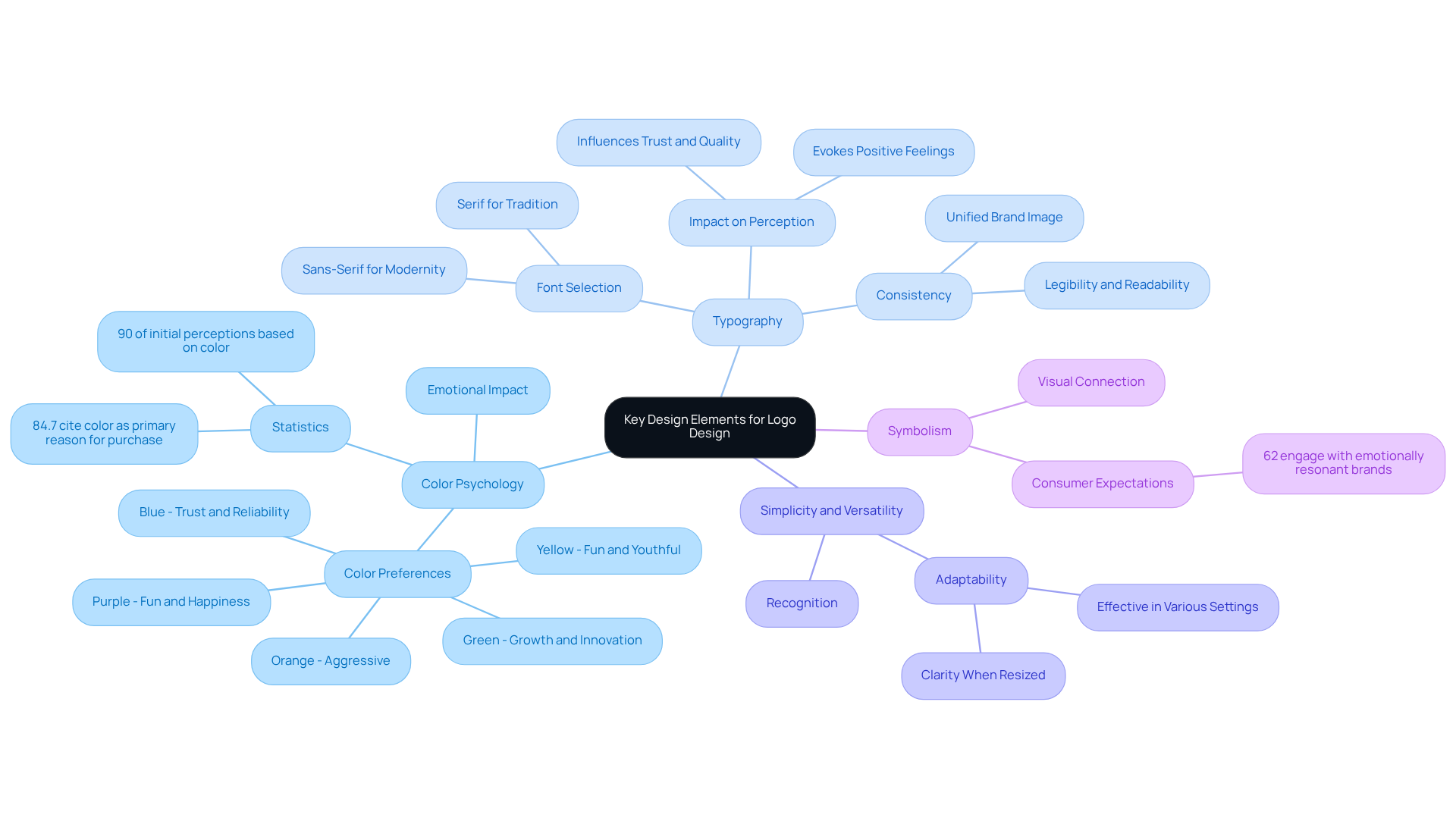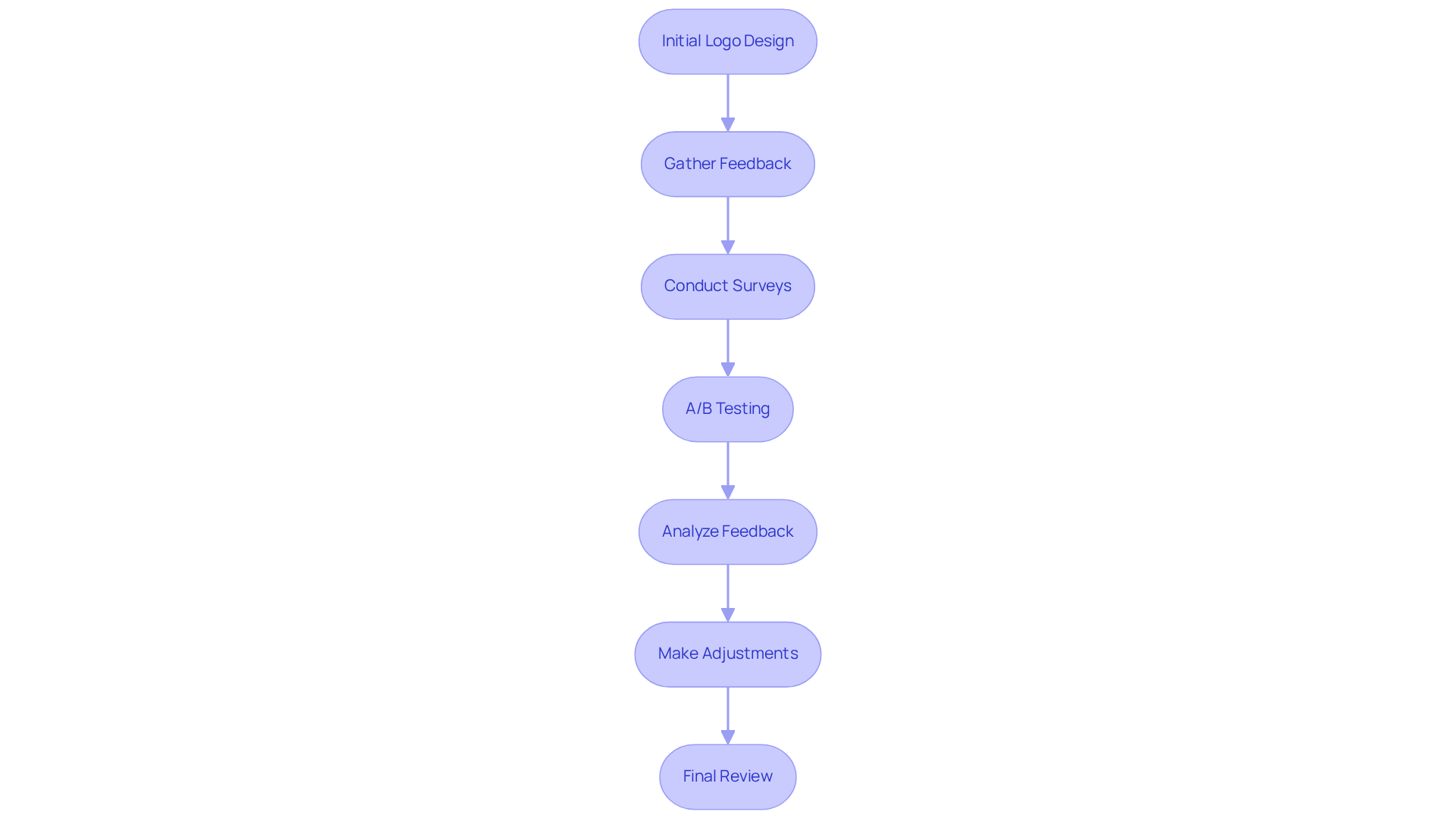Overview
For tech startups, logo design can often feel overwhelming. Many founders struggle with clearly defining their brand identity, which can lead to logos that fail to resonate with their target audience. This challenge not only affects brand recognition but can also hinder the startup's growth and connection with consumers. It's essential to understand the unique value propositions and the specific needs of your audience. Thoughtfully incorporating key design elements, such as color and typography, can significantly enhance the effectiveness of your logo.
At RNO1, we understand the emotional weight of this process. We believe that rigorous testing and refining of your logo is crucial, not just for aesthetic appeal but for fostering a genuine connection with your audience. By sharing personal stories and insights from industry leaders, we aim to nurture a supportive environment where you can feel confident in your design choices. Remember, a logo isn't just a symbol; it's an embodiment of your startup's mission and values. Together, we can create a logo that truly resonates with your consumers and reflects the heart of your brand.
Introduction
Designing a logo that truly captures the essence of a tech startup can feel like a daunting task for many founders. It’s easy to become overwhelmed by the countless options available, leaving you wondering if your vision will ever translate into a compelling visual identity. A well-crafted logo is more than just a symbol; it’s a powerful communicator of your brand’s identity and values, reaching out to your audience in a meaningful way. Yet, amidst the complexities of logo design, how can startups ensure that their emblem resonates with consumers and stands out in a crowded marketplace?
This article explores best practices for IT company logo design, offering nurturing insights into:
- Defining your brand identity
- Incorporating essential design elements
- Refining your logo through thoughtful testing and feedback
Together, we can navigate this journey, ensuring your brand shines brightly in the tech landscape.
Define Your Brand Identity
Designing a symbol that truly reflects your tech startup can feel overwhelming. Many founders grapple with defining their identity, which is essential for creating a logo that resonates. This journey involves articulating your mission, vision, and core values, but it can often lead to uncertainty and frustration. Let’s explore some steps together to ease this process:
- Identify Your : What sets your startup apart from others? It could be your groundbreaking technology, exceptional customer service, or a unique business model. Recognizing this distinction is vital for your brand’s identity.
- Understand Your Target Audience: Take the time to conduct thorough market research. Who are your customers? What do they value? Understanding their is crucial. Remember, 50% of consumers are more likely to support brands they recognize, highlighting the that speaks to them.
- Create a : Imagine a persona that embodies your startup’s essence. Is your brand playful and innovative, or serious and professional? This persona will guide your design choices, ensuring they resonate with consumer expectations and foster a sense of connection.
- Gather Inspiration: Look at logos from successful tech companies and identify what works. Consider color schemes, typography, and imagery that align with your identity. It’s noteworthy that , influencing their purchasing decisions. Strategic color use can significantly boost recognition and public perception, as illustrated in the study on 'The Role of Color in Branding.'
By clearly outlining your , you lay a strong foundation for an emblem that is not only visually appealing but also effectively communicates your startup’s essence. This thoughtful approach is crucial; after all, , making them essential for engaging consumers. Remember, you’re not alone in this journey—many have faced similar challenges, and with the right support, you can create a brand that truly reflects who you are.

Incorporate Key Design Elements
Once you have defined your , it’s essential to thoughtfully incorporate key design elements into the . Many founders struggle with this process, often feeling overwhelmed by the choices available. But understanding how to effectively use design can significantly impact your brand’s perception.
- : Choosing the right hues is more than just aesthetics; it’s about evoking the feelings you want your audience to experience. For instance, blue is widely recognized for conveying trust and reliability, while green symbolizes growth and innovation. It’s fascinating to note that studies reveal as much as 90% of individuals' initial perceptions of a product or label rely solely on color. This underscores the importance of making informed color selections that resonate with your [brand identity](https://blog.rno1.com/10-business-mission-statement-samples-for-tech-startups).
- Typography: The fonts you choose should reflect your identity's personality. Tech startups often find that modern, sans-serif fonts effectively convey innovation and simplicity. Remember, clear and legible typography is essential; studies indicate that consumer perception of product quality is significantly influenced by readability. By maintaining consistent typography across platforms, you foster a unified brand image, enhancing both recognition and trust.
- : A straightforward logo structure is vital for recognition and adaptability. Your emblem should , from website headers to app icons. Complex designs can lose clarity when resized, which may hinder recognition. Aim for a logo that is not only memorable but also adaptable to different contexts.
- Symbolism: Think about incorporating symbols or icons that represent your technology or services. This can , enhancing their memory of your company. Effective symbolism can align with consumer expectations; in fact, 62% of consumers are more likely to engage with companies that resonate with them emotionally.
By carefully weaving these visual components into your [best IT company logo design](https://blog.rno1.com/best-practices-for-b-2-b-digital-commerce-proven-strategies-for-success), you create an emblem that not only appears polished but also successfully conveys your brand's message. Remember, you are not alone in this journey; many founders share similar experiences, and together, we can cultivate a brand identity that truly reflects your vision.

Test and Refine Your Logo Design
After developing your initial logo design, it’s essential to recognize that rigorous testing and refinement are key to your success. Many startup founders face the daunting challenge of ensuring their . This is where the journey begins.
Gathering feedback is a powerful first step. Share your design with a focus group made up of potential clients, stakeholders, and design experts. Their insights can be invaluable. After all, 35% of adults often recognize the symbols of companies they prefer, highlighting just how important .
Next, consider conducting surveys. Online surveys can help you reach a broader audience and gather diverse opinions. Ask specific questions about your design’s attractiveness, clarity, and connection to your brand identity. This method can reveal crucial insights into consumer preferences; for instance, 25% of shoppers are more inclined to purchase from companies they recognize.
A/B testing is also a vital tool. By showcasing different design options, you can evaluate which one garners greater recognition and preference. This method is essential because —77% of B2C customers often decide based on brand reputation.
Once you’ve gathered insights, it’s time to iterate. Analyze the feedback and make necessary adjustments to your logo. Tweaking colors, fonts, or overall design can make a big difference. Remember, , making this step particularly crucial.
Finally, after making your adjustments, conduct a final review. Ensure your design aligns with your brand identity and meets the expectations of your target audience. Many businesses refresh their branding every 5-10 years to remain relevant in a constantly changing market.
By rigorously testing and refining your logo design, you significantly increase the likelihood of creating the that not only resonates with your audience but also effectively represents your . This thoughtful approach can pave the way for your success, .

Conclusion
Creating a logo for a tech startup can often feel overwhelming. Many founders struggle to encapsulate their brand's identity in a way that truly resonates with their audience. This challenge is not just about aesthetics; it’s about crafting a visual story that reflects the startup's mission, vision, and unique value proposition. When a logo captures these elements effectively, it becomes a powerful tool for connection.
As you navigate this process, consider essential practices such as:
- Defining your brand identity
- Understanding the impact of design elements like color psychology and typography
- Testing and refining your logo
Testing and refining your logo is crucial, ensuring that it stands out and communicates your core message clearly. By embracing these steps, you can create a logo that not only enhances recognition but also fosters emotional connections with your audience, driving deeper engagement.
In today’s competitive tech landscape, the importance of a thoughtfully designed logo cannot be overstated. It acts as a vital touchpoint between you and your audience, influencing how they perceive your brand and their purchasing decisions. By prioritizing these best practices, you empower your startup to cultivate a strong brand identity, one that captures attention and builds lasting relationships with customers. Investing time in thoughtful logo design is a crucial step toward establishing a memorable brand that resonates in the tech industry. Remember, you are not alone in this journey; many have faced similar challenges and emerged stronger. Together, we can create something remarkable.
Frequently Asked Questions
Why is defining brand identity important for a tech startup?
Defining brand identity is essential for creating a logo that resonates with consumers, articulates the startup's mission, vision, and core values, and sets the brand apart from competitors.
What is a unique value proposition and why is it significant?
A unique value proposition is what sets your startup apart from others, such as groundbreaking technology or exceptional customer service. Recognizing this distinction is vital for shaping your brand's identity.
How can understanding the target audience help in defining brand identity?
Conducting thorough market research to understand your target audience's values and perceptions is crucial. A well-defined identity that speaks to them increases the likelihood of consumer support, as 50% of consumers prefer recognizable brands.
What steps can be taken to create a brand identity?
To create a brand identity, imagine a persona that embodies your startup's essence and determine whether your brand is playful, innovative, serious, or professional. This persona will guide design choices to resonate with consumer expectations.
How can I gather inspiration for my brand's logo?
Look at logos from successful tech companies to identify effective elements such as color schemes, typography, and imagery that align with your identity.
What role does color play in branding?
Colors enhance visibility and influence purchasing decisions, with 85% of consumers believing that color affects their perception of brands. Strategic color use can significantly boost recognition and public perception.
How quickly do logos enhance recognition compared to text?
Logos enhance recognition 60,000 times faster than text, making them essential for engaging consumers effectively.
What should I remember during the process of defining my brand identity?
Remember that many founders face similar challenges in defining their brand identity, and with the right support and a thoughtful approach, you can create a brand that truly reflects who you are.




